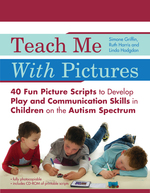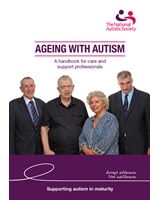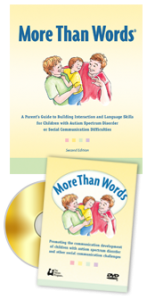On Friday I attended a conference: “Intensive Interaction and Play Techniques: encouraging Communication for Children with Autism”. I came back inspired — I can’t wait to try out the ideas!
Here’s a summary of two of the presentations.
Intensive Interaction
The keynote presentation was given by Dave Hewett, who, along with Melanie Nind, developed the Intensive Interaction approach. He pitched his talk at just the right level — making great use of video clips, the talk was both clear and fun.
Dave talked about the fundamentals of communication, such as enjoying being with another person, taking turns in exchanges of behaviour, and using and understanding eye contact. He questioned why most of the approaches we use to teach communication don’t attempt to teach these fundamentals of communication first. It seems obvious: if a child hasn’t acquired the fundamentals, it’s very difficult to learn anything else. So why do we tend to start by teaching symbolic representation?
Dave & co started working on Intensive Interaction because they felt the existing curriculum was inadequate — this was in the 1980s. He asked us to think about whether this is still the case today. We don’t expect babies to follow a timetable, so why do we expect this from children with Autism, some of whom are at the same developmental level?
Dave’s visualisation of communication learning and performance showed how complicated the process is. He suggested that the conventional linear teaching approach probably won’t work for something this complicated. He uses the idea of a spiral to describe learning through Intensive Interaction and play: learning takes off and spirals upwards; repetition means that each activity builds on what has gone before.
Again, this seems obvious to me. However, I often identify a target, and then consider which therapy activities I will use to work on it. Which takes me back to the linear model! I’m going to need to think about this: Dave suggested using video as a progress outcome, but I can’t write that on my goal sheet…
Attention: the Bucket
I also attended a workshop called: “Attention: getting it, building it and sharing it — the Bucket and Beyond”. Gina Davies started her session with a dancing chicken, giving us what she gives the children: “an irresistible invitation to learn.”
Like Dave, Gina also used video clips: she showed us a group of children with autism, before and after her 6 week program of attention work — it was amazing. The children in the ‘after’ clip were able to maintain such good attention that the Teaching Assistants in my group didn’t believe they were autistic.
As I understand it, Gina’s program works like this:
The children sit on chairs in a semi-circle facing the lead adult. The adult has an opaque bucket, with a lid on, containing highly motivating toys. She must be the most interesting thing in the room, so anything more interesting must be put out of sight. Along the same lines, the supporting adults should be boring! When a child gets up out of his chair, he must be slowly and calmly guided back to his seat — without verbal instructions.
The adult at the front takes out a toy from the bucket and demonstrates it to the children. The children’s reward must be intrinsic to the activity: the joy of watching a dancing pig! Gina suggested using 4 or 5 different toys in each session.
When the program begins, the children are only able to cope with sitting in their chairs for around 5 minutes, but after 2 mornings each week for 6 weeks they are able to maintain focussed attention for between 10 and 20 minutes. Each morning session is made up of around 4 cycles of 5 minutes bucket time and then a period of free play. Gina also said that at The Little Group, where she devised the program, they take the children running before they start the bucket time!
Gina was an outstanding presenter — I came home rambling on and on about buckets, and was so excited I had to text a friend, to share the bucket idea with her! I will definitely be giving this a try. I will also use it to support me in my quest to get the child-height sink removed from our therapy room; it’s competing with me as the most exciting thing in the room, so it has to go!
Gina also had lots of great ideas about motivating activities to do with the children once they had integrated attention. I need to email her and ask if I can add the flour castle, spagetti fireworks and lemonade fountain to this site!






